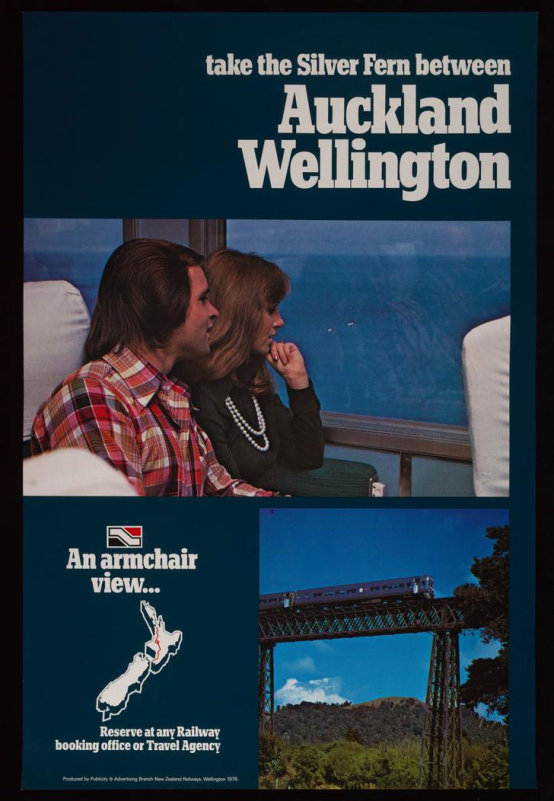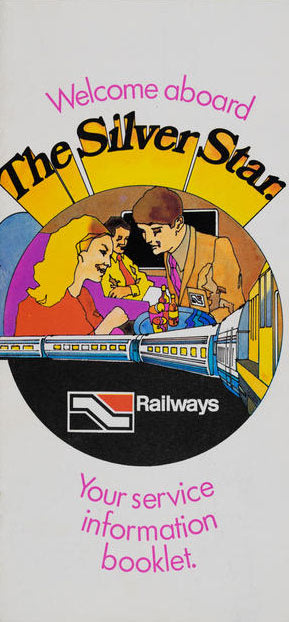All Aboard: Rail Hostesses of a Bygone Age

New Zealand Railways' Silver Fern railcar ran six days a week from 1972 to 1991. Named the Silver Fern because the exterior of the carriages was made from unpainted corrugated stainless steel, two services ran each day — one from Wellington to Auckland; one from Auckland to Wellington — each with two rail hostesses. If full, the railcars carried 96 passengers.
It was a long 12 ½-hour day for the hostesses. They arrived at the station at 7:30 a.m. and went straight to the train to prepare for the 8 a.m. departure. Hostesses would help the passengers board, distribute newspapers, offer drinks and snacks to passengers during the journey — as well as morning and afternoon tea. From 1972 to 1988, there was a lunch stop at Taihape, but that was replaced in later years by meals heated on board.

The crews changed over at a tiny place called Rangataua, just south of Ohakune. They hopped off the train, crossed the tracks, got on board the northbound service — and travelled back to Auckland, arriving at 7:30 in the evening. The changeover meant engaging with a completely new set of passengers, which was not always easy as the hostesses were starting to tire by this time. But according to former hostess Sue Rust, it was "Up to you to make the journey enjoyable for them."
The hostesses were encouraged to chat with the passengers — if they had time — and New Zealand Railways emphasised that they should think of themselves as ambassadors for the company and also for the government. As a result, they would help to order taxis and rental cars for passengers and provide tourist information, along with commentary pointing out sites of interest along the route. Rust recalled that with overseas passengers, "You generally got to have a really good talk with them, find out where they’d come from and what they were doing. In fact, two lots of American passengers that I had, I went and stayed with them when I went over to the States. It was wonderful."

The original smart red uniform was designed by a well-known Auckland clothes designer, Colin Cole, and tailor-made for each hostess. It was similar to air hostess uniforms of the time and included a coat and a hat — but NO trousers! The skirts were quite short, which were the fashion then, but caused a few problems with bending and lifting.
![Uniform Dress [Silver Star/Fern, Winter, Rail], 2014.411, MOTAT](https://images.ctfassets.net/mplktqcfflsk/2eZunG3OAydpnR6Qcq40oG/6594f3132d8f0c2765c8b05e08b24bd8/96a4eefd0a435e39beb7487fd941888e6490e584.jpg?w=504&h=800&fl=progressive&q=85&fm=jpg&bg=transparent)
The hostesses took their job seriously, said Rust. They were expected to have First Aid training, engage with international tourists, look after unaccompanied children, and spend a large part of their day serving alcohol on the train at a time when New Zealand’s liquor licensing laws were prescriptive.
Some of the women continued working for many years as Silver Fern hostesses despite the long hours, and in conditions which were not particularly great — the galley was tiny; they had no place to rest if all the seats were booked; and there was the possibility of bad accidents. A couple of times there were fatalities at level crossings and on 18 August 1981, the railcar derailed north of Waiōuru, resulting in four deaths.
You can still take a train between Auckland and Wellington (the Northern Explorer), but cheap airfares mean that the route is now predominantly used by tourists. Alas, the golden age of rail travel has faded — but not the fond memories of New Zealand Railway hostesses.
Story by Megan Hutching, Oral Historian, MOTAT
Visit MOTAT's Online Collections for more NZ Rail items
Citation:
Hutching, Megan. 2022. A Long Day in a Tin Can’ — Rail Hostesses of a Bygone Age. New Zealand: The Museum of Transport and Technology (MOTAT). First published: 5 January 2022. URL www.motat.nz/rail-hostesses-of-a-bygone-age